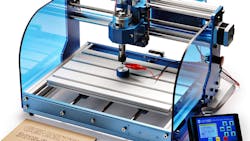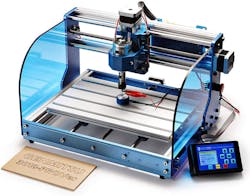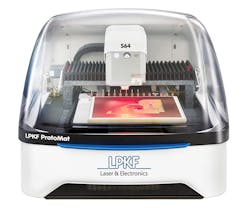CNC Your PCB Prototype
This article is part of the TechXchange: PCB Tools and Technology
What you’ll learn
- How milling machines can be used to create simple PCBs.
- Challenges of using low-cost solutions.
- Higher-end alternatives.
One challenge with focusing on the latest high-tech solutions is that with so much going on, you can miss useful alternatives in other areas. That happened with me while judging the recent Robot Design Competition for the Mercer Science and Engineering Fair. Part of the discussion was about the challenges of creating printed circuit boards (PCBs) and soldering surface-mount technology (SMT) electronics. The latter is a whole other conversation unto itself, but it was the PCB discussion that I want to highlight.
One of our judges is a professor at a nearby college, and his answer to creating custom PCBs is to have his students use a SainSmart Genmitsu CNC Routing Machine (Fig. 1). The low-cost computer-numerical-control (CNC) machine is just one of many on the market capable of milling a circuit board from a raw slab of copper-clad non-conductive substrate.
Like 3D printers, low-cost 3D CNC machines have improved significantly over time. Likewise, the software available for PCB design and control of these machines has become easier to use and more readily available, often as open-source solutions. They’re also a good complement to 3D printers for the application space we were judging, as many of the students were already using 3D printers to create custom robot frames.
The price of low-cost 3D printers and CNC machines is on the order of a mid-range printer these days, making them affordable to students as well as full-time engineers.
Low-cost solutions do have their limitations, though. Speed and accuracy are often at the forefront, along with limitations on the size of the work area. Still, for many applications, these limitations aren’t problems. Likewise, especially for PCBs, building multiple linked boards is one way to create solutions within the confines of the tools.
The performance of these low-end machines is often more than sufficient for many projects. On top of that, there’s actually a spread of solutions from the low end to the high end. The 3D-printer market has a similar blend of price/performance solutions and a variety of different implementations.
This isn’t the first time I’ve encountered CNC machines used to build PCBs. It was more than a decade ago that I covered LPKF’s ProtoMat milling machine (Fig. 2), which is a professional-level solution to the problem. At the time, there were few low-cost 3D printers and the ProtoMat wasn’t cheap. They’re still expensive, but for good reason as they’re much more capable and accurate, not to mention faster. The added precision allows for creation of fine details like on-board antennas. The alignment even makes it possible to build multilayer boards.
A different approach is taken by Nano Dimension’s DragonFly 2020 3D printer (Fig. 3). It’s an additive approach similar to 3D printing but using metallic inks. They can create PCBs that closely match the performance of PCBs developed using mass-production facilities. The DragonFly comes at a premium price like LPKF’s solution because it addresses more professional requirements such as speed, accuracy, and maximum size of the circuit board.
Rapid prototyping is key to getting products out the door and tools like 3D CNC machines are part of the solution. They can do more than just carve the name of the product onto a nameplate and are a versatile addition to a developer’s toolbox.
About the Author
William G. Wong
Senior Content Director - Electronic Design and Microwaves & RF
I am Editor of Electronic Design focusing on embedded, software, and systems. As Senior Content Director, I also manage Microwaves & RF and I work with a great team of editors to provide engineers, programmers, developers and technical managers with interesting and useful articles and videos on a regular basis. Check out our free newsletters to see the latest content.
You can send press releases for new products for possible coverage on the website. I am also interested in receiving contributed articles for publishing on our website. Use our template and send to me along with a signed release form.
Check out my blog, AltEmbedded on Electronic Design, as well as his latest articles on this site that are listed below.
You can visit my social media via these links:
- AltEmbedded on Electronic Design
- Bill Wong on Facebook
- @AltEmbedded on Twitter
- Bill Wong on LinkedIn
I earned a Bachelor of Electrical Engineering at the Georgia Institute of Technology and a Masters in Computer Science from Rutgers University. I still do a bit of programming using everything from C and C++ to Rust and Ada/SPARK. I do a bit of PHP programming for Drupal websites. I have posted a few Drupal modules.
I still get a hand on software and electronic hardware. Some of this can be found on our Kit Close-Up video series. You can also see me on many of our TechXchange Talk videos. I am interested in a range of projects from robotics to artificial intelligence.




